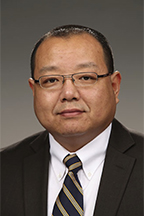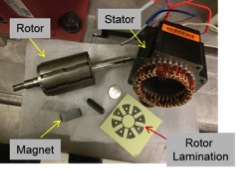 New MatE professor immersed in research in Ames
New MatE professor immersed in research in Ames
Upon his arrival in Ames, Jun Cui jumped right into five different areas of research both in the Department of Materials Science and Engineering on campus and with the Materials Science and Engineering Division at the U.S. Department of Energy’s Ames Laboratory.
Cui, originally from China, says he was guided into the study of materials science by his parents. He earned his B.S. in MSE from Zhejiang University in Hangzhou, China, and then came to the U.S., where he attended the University of Minnesota for his master’s degree in electrical engineering and his Ph.D. in mechanics.
His post-doctoral work was done at the University of Maryland at College park, where he worked as a research associate until 2005, and then as an adjunct professor. Simultaneously, he started work at GE as a Materials Scientist. Following GE, Cui worked as a senior scientist at Pacific Northwest National Lab for five years before arriving at Iowa State in fall 2015 to start his time as an associate professor.
Cui’s research focuses on a variety of magnetic applications, the first of which is permanent magnets being used for motors. These magnetic motors are used in a number of ways, all the way down to the vibration capabilities in modern smartphones. Cui says the more powerful the magnet, the more compact the motor can be, but some of the most powerful magnets are created from rare earth metals.
 “The two particular rare earth elements that are critical for motors are mainly concentrated in China, which has half of the whole world’s reserves,” Cui explains. “Lots of different countries have some amounts of them, but it’s really a matter of how cheaply you can extract it.”
“The two particular rare earth elements that are critical for motors are mainly concentrated in China, which has half of the whole world’s reserves,” Cui explains. “Lots of different countries have some amounts of them, but it’s really a matter of how cheaply you can extract it.”
This is where the Critical Material Institute (CMI) within the Ames Laboratory comes into play. CMI is working to improve the rare earth process in a number of ways, including funding alternative materials, creating more efficient extraction technologies and recycling the highly-demanded materials.
Cui’s work focuses on developing powerful magnets that use a smaller proportion of rare earth materials or substituting different materials entirely. “I’m more known for the non-rare earth-based magnet; a manganese-based magnet nearly as powerful at high temperatures,” he says. While this magnet does not have the full capacity of a magnetic motor that uses rare earth materials, Cui says only 10-20% of the applications actually require this kind of power.
Cui also does research on magnetic materials for his work at the Ames Laboratory. There, he works with “soft” magnets instead of “hard” or permanent magnets. Soft magnets are those that can be easily influenced by a magnetic field, and while they are heavily used in motors, their use (as opposed to the use of permanent magnets) means the motor must be larger because of the addition of copper bars to create a driving current. However, using soft magnetic materials is far cheaper and doesn’t require rare earth materials.
The main soft magnetic material that is being studied (by a number of universities and labs because of the sheer size of the market) is called “silicon steel,” also known as electric steel. Currently, this material containing 3.2% silicon has the most well-balanced cost/performance ratio, according to Cui, however, the green energy applications are demanding better soft magnetic materials in terms of energy efficiency and cost. The challenge for researchers like Cui is to continue to make the technology more efficient.
But Cui’s research doesn’t end there. He also spends time researching magnetic liquefaction for gasses like hydrogen, helium, and natural gas. By liquefying a gas, the material can be purified and transported more easily and economically.
Another area of his research, high-temperature alloys, involves using metal alloys to make machines, such as an aircraft engine, lighter and more powerful. Developing next-generation engine materials is an enormous project, too big for just Iowa State researchers, but Cui and his colleagues come up with the principles for these alloys and then allow external companies to take over and apply their own protocol.
The final area of Cui’s work is a cooling technology using caloric materials. Caloric materials are those that go through transitions to release or absorb heat. There are different caloric areas, such as electro-caloric, which deals with electric fields, or magneto-caloric, which deals with magnetic fields, but Cui is focusing on developing the area of elasto-caloric systems, which deal with stress fields. This research takes place in the Institute of Caloric Cooling, where Cui is the deputy director.
While Cui says that his hobby has become research due to the large number of projects he works on, he occasionally plays golf, often with his colleagues. He is most looking forward to working with students and post-docs to help them to think in experimental and theoretical frameworks and prepare them for a career dedicated to green energy.